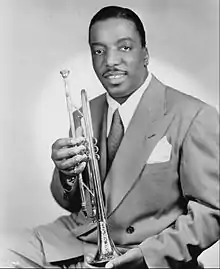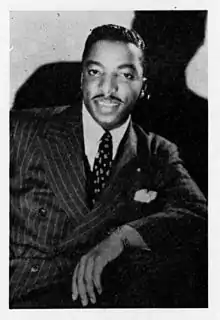Erskine Hawkins
Erskine Ramsay Hawkins (July 26, 1914 – November 11, 1993)[1] was an American trumpeter and big band leader from Birmingham, Alabama, dubbed "The 20th Century Gabriel".[2] He is most remembered for composing the jazz standard "Tuxedo Junction" (1939) with saxophonist and arranger Bill Johnson. The song became a popular hit during World War II, rising to No. 7 nationally (version by the Erskine Hawkins Orchestra) and to No. 1 nationally (version by the Glenn Miller Orchestra). Vocalists who were featured with Erskine's orchestra include Ida James, Delores Brown, and Della Reese. Hawkins was named after Alabama industrialist Erskine Ramsay.
Erskine Hawkins | |
|---|---|
 Hawkins circa 1940s | |
| Background information | |
| Birth name | Erskine Ramsay Hawkins |
| Born | July 26, 1914 Birmingham, Alabama, U.S. |
| Died | November 11, 1993 (aged 79) Willingboro Township, New Jersey |
| Genres | Jazz, blues |
| Occupation(s) | Musician, composer, bandleader |
| Instruments | Trumpet |
| Years active | 1930s–1980s |
| Labels | Vocalion, RCA |
| Website | example |
Early years
Erskine Hawkins was named by his parents after Alabama industrialist Erskine Ramsay who was rewarding parents with savings accounts for them for doing so. Hawkins attended Councill Elementary School and Industrial High School (now known as Parker High School) in Birmingham, Alabama. At Industrial High School, he played in the band directed by Fess Whatley, a teacher who trained numerous African-American musicians, many of whom populated the bands of famed band leaders such as Duke Ellington, Lucky Millinder, Louis Armstrong and Skitch Henderson (of the NBC Orchestra.)
Headliner years
During 1936 through 1938, he recorded for Vocalion Records as "Erskine Hawkins and his 'Bama State Collegians". In 1938, he signed with RCA Victor Records and began recording on their Bluebird label as, simply, "Erskine Hawkins and His Orchestra".
In the late 1930s Hawkins and his Orchestra were one of the house bands at the Savoy Ballroom. They alternated with the Chick Webb band, and often used Tuxedo Junction as their sign-off song before the next band would take the stage, so that the dancing would continue uninterrupted. Hawkins also engaged in "battles of the bands" with such bandleaders as Glenn Miller, Duke Ellington, and Lionel Hampton.[3]
In the mid 1940s, he was transferred to the main RCA Victor label, recording many of his greatest hits for both labels during this decade. He remained with them until 1950 when he switched over to Coral Records. He continued to record for many years.
Later years

Hawkins was trumpeter and band leader in the lobby bar and show nightclub at The Concord Resort Hotel in Kiamesha Lake, New York from 1967 to 1993 with his last performing group Joe Vitale piano, Dudly Watson bass, Sonny Rossi vocals & clarinet, and George Leary drums . Hawkins died at his home in Willingboro Township, New Jersey in November 1993, after a brief visit with his sister in Alabama before he was able to return to resume playing with his band at the Concord at the age of 79.[1] He is buried in Elmwood Cemetery, alongside his sister, in Birmingham, Alabama.
Personal life
Flo Hawkins, who appeared in the film That Man of Mine, was his wife. They eventually became estranged and she worked in the Catskills.[4]
Induction into the Alabama Jazz Hall of Fame
In 1978, Erskine Hawkins became one of the first five artists inducted into the Alabama Jazz Hall of Fame. In 1989, he was inducted into the Alabama Music Hall of Fame.[1] Hawkins was a contemporary of another Birmingham jazz musician, Sun Ra. The story of the Hawkins legacy continues to be told today, during tours of the Alabama Jazz Hall of Fame Museum, by Ray Reach (Director of Student Jazz Programs) and Frank Adams, (Director of Education, Emeritus) at the Alabama Jazz Hall of Fame.
Tributes
On his final Sunday night radio show (July 26, 2009) Malcolm Laycock celebrated the 95th anniversary of Hawkins' birth, by featuring music performed by Hawkins. In 2011, the story of Erskine Hawkins and the Bama State Collegians was the subject of a Florida State University Film School MFA Thesis Film "The Collegians", written and directed by Bryan Lewis.[5][6]
Chart singles
| Year | Single | Chart positions | ||||
|---|---|---|---|---|---|---|
| Pop | US R&B | |||||
| 1936 | "Until the Real Thing Comes Along" | 20 | ||||
| "Big John's Special" | 18 | |||||
| 1937 | "Way Down Upon the Swanee River" | 17 | ||||
| 1939 | "Do You Wanna Jump, Chillun?" | 16 | ||||
| "Tuxedo Junction" | 7 | |||||
| 1940 | "Whispering Grass" | 13 | ||||
| "Dolemite" | 10 | |||||
| "Five O Clock Whistle" | 15 | |||||
| 1941 | "Song of the Wanderer" | 21 | ||||
| "Nona" | 17 | |||||
| 1942 | "Wrap Your Troubles in Dreams" | 23 | ||||
| "Bicycle Bounce" | 5 | |||||
| 1943 | "Don't Cry Baby" | 11 | 1 | |||
| 1944 | "Cherry" | 15 | 5 | |||
| 1945 | "Tippin' In" | 9 | 1 | |||
| "Caldonia" | 12 | 2 | ||||
| "Fifteen Years (And I'm Still Serving Time)" | 4 | |||||
| 1946 | "Sneakin' Out" | 5 | ||||
| "I've Got A Right to Cry" | 2 | |||||
| "After Hours" | 3 | |||||
| 1947 | "Hawk's Boogie" | 2 | ||||
| 1948 | "Gabriel's Heater" | 28 | ||||
| 1949 | "Corn Bread" | 8 | ||||
| 1950 | "Tennessee Waltz" | 6 | ||||
References
- "The Dead Rock Stars Club 1992 - 1993". Thedeadrockstarsclub.com. Retrieved January 25, 2020.
- Yanow, Scott. "Erskine Hawkins: Biography". Allmusic. Retrieved 20 January 2011.
- Wanser, Jeff (8 October 2007). "Erskine Hawkins". Encyclopedia of Alabama. Alabama Humanities Foundation. Retrieved 4 August 2014.
- https://books.google.com/books?id=p78DAAAAMBAJ&pg=PA63&dq=flo+hawkins&hl=en&sa=X&ved=2ahUKEwjLr6jAitfrAhUywVkKHbr7DokQ6AEwBHoECAEQAQ#v=onepage&q=flo%20hawkins&f=false
- "Thomas Wilson - More archives..." Facebook.com. Retrieved January 25, 2020.
- "The Collegians Trailer". YouTube. Retrieved January 25, 2020.
- Whitburn, Joel (1986). Pop Memories. Record Research Inc. p. 201. ISBN 0-89820-083-0.
- Whitburn, Joel (2006). Top 40 R&B and Hip-Hop Hits. Billboard Books. p. 236. ISBN 0-8230-8283-0.
External links
- Erskine Hawkins biography at the Alabama Music Hall of Fame website
- Erskine Hawkins biography at Allmusic.com
- Interview with Brownie McGhee [Tapes #010 & 011 - Discovers Erskine Hawkins with TB in sanatorium, forms band at 27:00 minutes